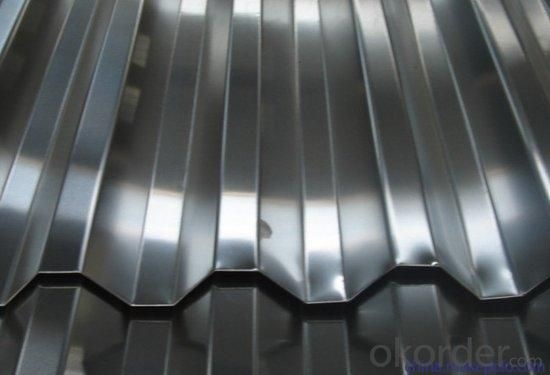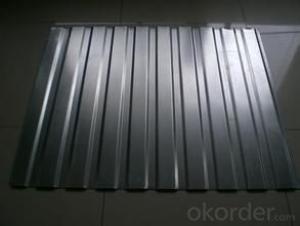Galvanized Sheet Corrugated Panels with Best Quality
- Loading Port:
- Tianjin
- Payment Terms:
- TT or LC
- Min Order Qty:
- 500 m²
- Supply Capability:
- 5000 m²/month
OKorder Service Pledge
OKorder Financial Service
You Might Also Like
Specifications
1.various colors
2.beautiful appearance
3.waterproof,corrosion resistance,long span
4.high strength
5.easy installation
Application
It is widely used as thermal insulation material for high-temperature pipe, tank, equipment and vessel in petroleum, chemical and metallurgy industry. It can also be applied to partition, ceiling and building wall as thermal insulation and sound absorption material in construction industry.
Features
1 excellent insulation functions
2 good fireproofing
3 heavy load bearing capacity
4 can be designed as special requirement
production description
thickness:
the thickness of upper and lower plate:0.0-0.6mm
rock wool:50mm-150mm
Advantages:
1.heat,sound insulation.
2.strong moisture proofness .
3.excellent fire protecting performance.
4.smoke free, non-poisonous.
5.smooth appearance ,beautiful appearance.
6.colorful, different colors can be provided.
We can provide different special specification according to customers' requirements.
Application:
Widely used for Ships, metallurgy, electric power, construction and other industries.
Our Rock Wool Panel mostly used for building wall, roof heat preservation sound insulation; Building walls, firewall, fire doors and elevator well fire and noise reduction.
Normal size:
thickness of Rock Wool:50,75,100mm,150mm
top board:0.3-0.5mm,back board:0.3-0.5mm.
can be designed by customers' requirements.

- Q:What are the different sheet metal welding techniques for steel sheets?
- There are several different sheet metal welding techniques that can be used for steel sheets. Some of the most common techniques include: 1. Gas Metal Arc Welding (GMAW): Also known as MIG welding, this technique uses a continuous wire electrode to create an arc and join the steel sheets together. It is a versatile and efficient method, suitable for both thin and thick sheets. 2. Gas Tungsten Arc Welding (GTAW): Commonly referred to as TIG welding, this technique uses a non-consumable tungsten electrode to create an arc and join the steel sheets. It produces high-quality welds with excellent control and is often used for thin or delicate sheet metal. 3. Resistance Spot Welding (RSW): In this technique, two electrodes apply pressure and pass a high electrical current through the steel sheets, causing them to fuse together. It is a quick and cost-effective method commonly used in automotive and manufacturing industries. 4. Laser Welding: This technique uses a high-energy laser beam to melt and join the steel sheets. It offers precise control, high welding speeds, and minimal heat input, making it suitable for thin and highly reflective materials. 5. Electron Beam Welding (EBW): This method uses a focused beam of high-velocity electrons to create a weld. It offers deep penetration and is commonly used for thick steel sheets or in applications where a high-quality weld is required. 6. Plasma Arc Welding (PAW): Similar to TIG welding, this technique uses a plasma arc to create a weld. It offers higher welding speeds and can be used for both thick and thin steel sheets. Each of these techniques has its advantages and limitations, and the appropriate choice depends on factors such as the thickness of the steel sheets, desired weld quality, production volume, and available equipment.
- Q:Are steel sheets suitable for oil and gas pipelines?
- Yes, steel sheets are suitable for oil and gas pipelines. Steel is a strong and durable material that can withstand high pressure and extreme temperatures, making it an ideal choice for pipelines that transport oil and gas over long distances. Additionally, steel sheets can be easily welded together to create a continuous pipeline, ensuring a reliable and leak-free transportation system.
- Q:Are steel sheets suitable for roofing systems?
- Yes, steel sheets are suitable for roofing systems. Steel is a durable and long-lasting material that offers excellent protection against weather elements, such as rain, snow, and hail. It is also fire-resistant and can withstand high winds. Additionally, steel sheets are lightweight, making them easier to install and maintain.
- Q:What are the different color options available for steel sheets?
- Steel sheets can be available in a variety of color options, depending on the specific requirements and preferences. Some common color options for steel sheets include: 1. Natural Steel: This is the most common color option for steel sheets, which is the natural color of the steel surface without any additional coating or treatment. It has a silver-grey appearance. 2. Galvanized Steel: Galvanization is a process in which a protective zinc coating is applied to the steel sheet. This results in a shiny silver color, providing enhanced corrosion resistance. 3. Coated Steel: Steel sheets can be coated with various materials to provide different colors and additional protection. These coatings can include polyester, silicone polyester, polyvinylidene fluoride (PVDF), or plastic film coatings. These coatings can be available in a wide range of colors, including white, red, blue, green, and more. 4. Painted Steel: Steel sheets can also be painted with various types of paint, such as epoxy, polyurethane, or acrylic. This allows for a virtually unlimited range of color options, including standard colors like black, grey, white, as well as custom colors to match specific requirements. It is important to note that the availability of different color options may vary depending on the specific supplier and the intended application of the steel sheets. Additionally, different color options may also have different performance characteristics, such as improved resistance to UV radiation or enhanced durability.
- Q:How are steel sheets tested for quality and performance?
- Steel sheets are tested for quality and performance through various methods such as mechanical testing, chemical analysis, and visual inspection. Mechanical testing involves subjecting the steel sheets to stress, tension, and hardness tests to determine their strength and durability. Chemical analysis is conducted to assess the composition and purity of the steel, ensuring it meets the required standards. Visual inspection checks for any surface defects, such as cracks, scratches, or unevenness in the steel sheets. These comprehensive testing methods ensure that steel sheets meet the desired quality and performance criteria.
- Q:Can steel sheets be used for roofing purposes?
- Yes, steel sheets can be used for roofing purposes. Steel roofing sheets are commonly used in commercial and industrial buildings, as well as residential homes. They are known for their durability, longevity, and resistance to harsh weather conditions such as rain, snow, and wind. Steel sheets are available in various profiles and finishes, allowing for customization to suit different architectural styles and design preferences. Additionally, steel roofing is lightweight, fire-resistant, and often made from recycled materials, making it an environmentally friendly roofing option. Overall, steel sheets are a popular choice for roofing due to their strength, versatility, and aesthetic appeal.
- Q:What are the different jointing methods for steel sheets?
- Steel sheets can be joined using various methods, depending on specific requirements and applications. Common jointing methods for steel sheets include welding, bolting, riveting, adhesive bonding, and mechanical fasteners. Welding is widely used, involving melting the steel sheet edges and joining them by applying heat and pressure. Different welding techniques, like arc welding, gas welding, or laser welding, can be used depending on the steel sheet thickness and type. Bolting involves using bolts and nuts to join steel sheets together. This method is suitable for easily disassembling or replacing joints and can be used for both permanent and temporary connections. Riveting is another method, using rivets to join steel sheets. Rivets are cylindrical metal pins inserted through holes in the sheets and deformed to secure the joint. Riveting is ideal for applications requiring high shear strength. Adhesive bonding uses specialized adhesives to join steel sheets. This method provides a strong and durable joint, suitable when welding or other mechanical jointing methods are not suitable. Adhesive bonding also distributes stress more uniformly across the joint. Mechanical fasteners, like clips, clamps, or brackets, can be used to join steel sheets. These fasteners offer a secure and reliable connection without requiring welding or other permanent jointing methods. They are commonly used when ease of assembly and disassembly is necessary. In conclusion, the choice of jointing method for steel sheets depends on factors such as the application, desired strength and durability, and ease of assembly and disassembly. Careful consideration of these factors is essential to ensure a successful and reliable connection.
- Q:Can steel sheets be used for agricultural applications?
- Yes, steel sheets can be used for agricultural applications. Steel is a versatile material that offers strength, durability, and resistance to corrosion, making it suitable for various agricultural purposes such as building structures, fencing, roofing, and equipment.
- Q:What is the average weight of a steel sheet per square meter?
- The average weight of a steel sheet per square meter depends on the thickness and type of steel, but it typically ranges from 7.85 to 8.05 kilograms per square meter.
- Q:What is the difference between a smooth and patterned steel sheet?
- A smooth steel sheet typically has a plain, uniform surface without any visible patterns or textures. It has a consistent and sleek appearance, making it suitable for applications where a clean, modern look is desired. On the other hand, a patterned steel sheet features various designs or textures that are embossed or etched onto the surface. These patterns can range from simple geometric shapes to intricate motifs. Patterned steel sheets are often chosen for their decorative appeal and ability to add visual interest to a space. They can be used in architectural elements, such as wall panels or ceiling tiles, to create a unique and artistic effect. In terms of functionality, smooth steel sheets may offer slightly better corrosion resistance due to their smoother surface, making them suitable for applications where protection against rust is important, such as in outdoor or marine environments. Conversely, patterned steel sheets may have reduced corrosion resistance due to the variation in surface texture, potentially offering less protection against rust. Overall, the choice between a smooth and patterned steel sheet depends on the desired aesthetic, functional requirements, and the intended application.
1. Manufacturer Overview |
|
|---|---|
| Location | |
| Year Established | |
| Annual Output Value | |
| Main Markets | |
| Company Certifications | |
2. Manufacturer Certificates |
|
|---|---|
| a) Certification Name | |
| Range | |
| Reference | |
| Validity Period | |
3. Manufacturer Capability |
|
|---|---|
| a)Trade Capacity | |
| Nearest Port | |
| Export Percentage | |
| No.of Employees in Trade Department | |
| Language Spoken: | |
| b)Factory Information | |
| Factory Size: | |
| No. of Production Lines | |
| Contract Manufacturing | |
| Product Price Range | |
Send your message to us
Galvanized Sheet Corrugated Panels with Best Quality
- Loading Port:
- Tianjin
- Payment Terms:
- TT or LC
- Min Order Qty:
- 500 m²
- Supply Capability:
- 5000 m²/month
OKorder Service Pledge
OKorder Financial Service
Similar products
New products
Hot products
Related keywords






























